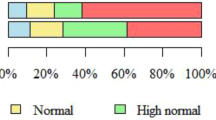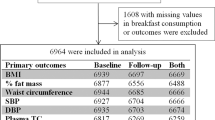Abstract
OBJECTIVE: To examine associations between sociodemographic, dietary factors and physical activity and the prevalence of obesity in the Belgian general population.
DESIGN: Base-line data from the Belgian Interuniversity Research on Nutrition and Health (BIRNH) study (1979–1984).
SUBJECTS: A total of 5837 men and 5243 women aged 25–74 y were included in the analysis. The sample was considered representative of the Belgian population.
MEASUREMENTS: Using the body mass index (BMI) as the criterion, obesity was defined as a BMI≥30 kg/m2. Nutritional data were assessed by a 24 h food record. Physical activity level (PAL) was calculated by dividing total caloric intake by an estimation of basal metabolic rate (BMR, predicted from gender, weight and age). Age-adjusted odds ratios (OR) of the prevalence of obesity were estimated by multilogistic regression analysis.
RESULTS: Prevalence of obesity was 12.1% in men and 18.4% in women. In both sexes, prevalence of obesity increased gradually in each 10-year age category (P<0.0001) and steeply decreased with level of education. Comparing lowest (Q1) to highest quartile (Q4), after adjustment for age, prevalence of obesity decreased with total carbohydrate intake, as well as total sugar intake in both sexes, and increased with total fat intake only in men. Obesity increased with a high fat to sugar ratio (men: ORQ4/Q1=1.56; confidence interval (CI): 1.25–1.93; women: ORQ4/Q1=1.45; CI: 1.17–1.80). PAL was inversely and very strongly associated with obesity (men: ORQ4/Q1=0.20; CI: 0.15–0.26; women: ORQ4/Q1=0.18; CI: 0.14–0.23). The same associations were observed with the mean BMI.
CONCLUSION: This study indicates that prevalence of obesity is particularly high in Belgium. Low level of education and reduced physical activity, increased fat intake and especially elevated fat to sugar ratio appear to be powerful determinants of obesity in this Belgian population.
This is a preview of subscription content, access via your institution
Access options
Subscribe to this journal
Receive 12 print issues and online access
$259.00 per year
only $21.58 per issue
Buy this article
- Purchase on Springer Link
- Instant access to full article PDF
Prices may be subject to local taxes which are calculated during checkout
Similar content being viewed by others
Author information
Authors and Affiliations
Rights and permissions
About this article
Cite this article
Stam-Moraga, M., Kolanowski, J., Dramaix, M. et al. Sociodemographic and nutritional determinants of obesity in Belgium. Int J Obes 23 (Suppl 1), S1–S9 (1999). https://doi.org/10.1038/sj.ijo.0800788
Published:
Issue Date:
DOI: https://doi.org/10.1038/sj.ijo.0800788
Keywords
This article is cited by
-
Fat free mass and obesity in relation to educational level
BMC Public Health (2009)
-
A procedure to correct proxy-reported weight in the National Health Interview Survey, 1976–2002
Population Health Metrics (2009)
-
Socio-economic and lifestyle factors associated with overweight in Flemish adult men and women
BMC Public Health (2007)
-
Dietary factors associated with obesity indicators and level of sports participation in Flemish adults: a cross-sectional study
Nutrition Journal (2007)
-
Social class, parental education, and obesity prevalence in a study of six-year-old children in Germany
International Journal of Obesity (2005)



